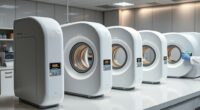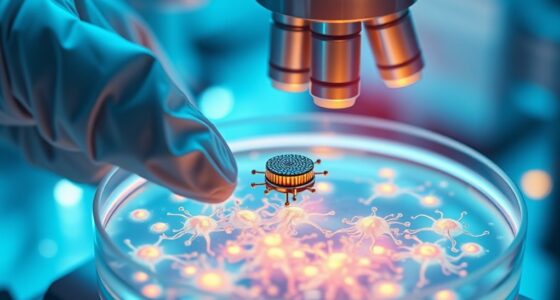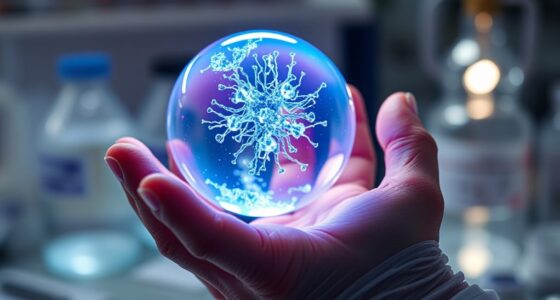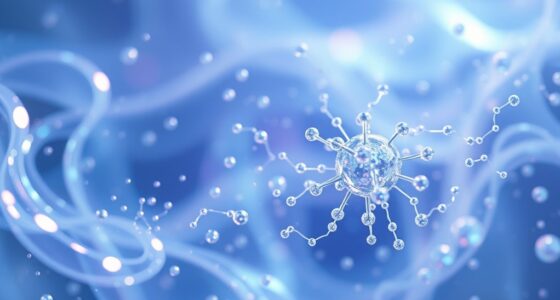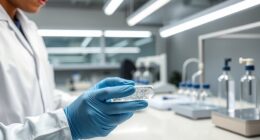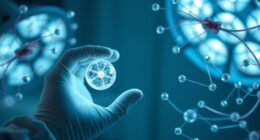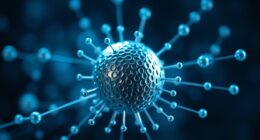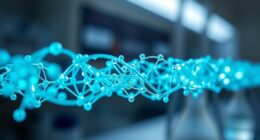Therapeutic nanobubbles and ultrasound-driven nanomachines are innovative tools for targeted medicine. They use tiny, gas-filled vesicles with protective shells to carry drugs or improve imaging. Ultrasound acts as a trigger, controlling when and where these nanomachines release therapy or activate. This technology enhances diagnosis, improves drug precision, and minimizes side effects. To discover how these advancements are shaping future treatments, explore more about their capabilities and potentials.
Key Takeaways
- Nanobubbles are gas-filled vesicles (<200 nm) used for targeted drug delivery, enhanced imaging, and therapeutic applications in medicine.
- Ultrasound acts as an external trigger to activate nanomachines, enabling controlled drug release and therapeutic effects.
- These nanostructures improve diagnostic imaging by serving as contrast agents and targeting disease biomarkers precisely.
- Ultrasound-driven nanomachines can cross biological barriers like the blood-brain barrier for advanced treatments.
- Challenges include ensuring biocompatibility, scalable manufacturing, and precise targeting for effective clinical use.
Understanding Therapeutic Nanobubbles: Structure and Function
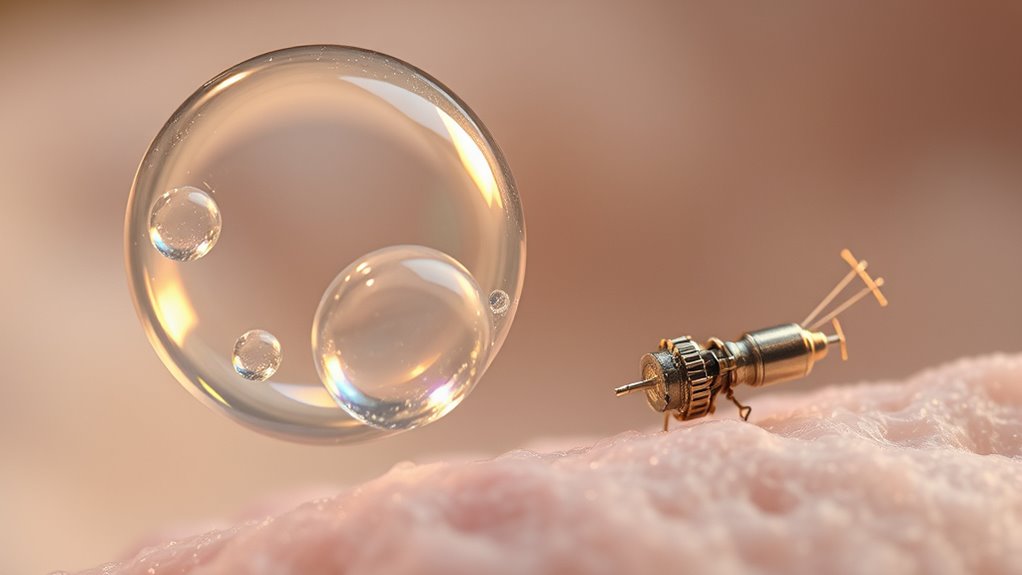
Therapeutic nanobubbles are tiny gas-filled vesicles, typically less than 200 nanometers in diameter, designed to enhance medical treatments. Their small size allows them to circulate through blood vessels easily, reaching target tissues more effectively. The bubbles consist of a core filled with inert gas, surrounded by a stabilizing shell made from lipids, proteins, or polymers. This shell protects the gas and provides stability during circulation. When exposed to specific stimuli, such as ultrasound, they can release drugs or generate effects that improve treatment outcomes. Their ability to carry therapeutic agents directly to affected areas minimizes side effects and increases efficiency. Additionally, their WWE Raw’s Financial Impact demonstrates how entertainment industries can generate significant revenue, paralleling the potential commercial success of nanomedical technologies. Overall, nanobubbles serve as versatile carriers, combining physical stability with targeted delivery, making them promising tools in modern medicine.
Ultrasound Activation: How Nanomachines Are Controlled
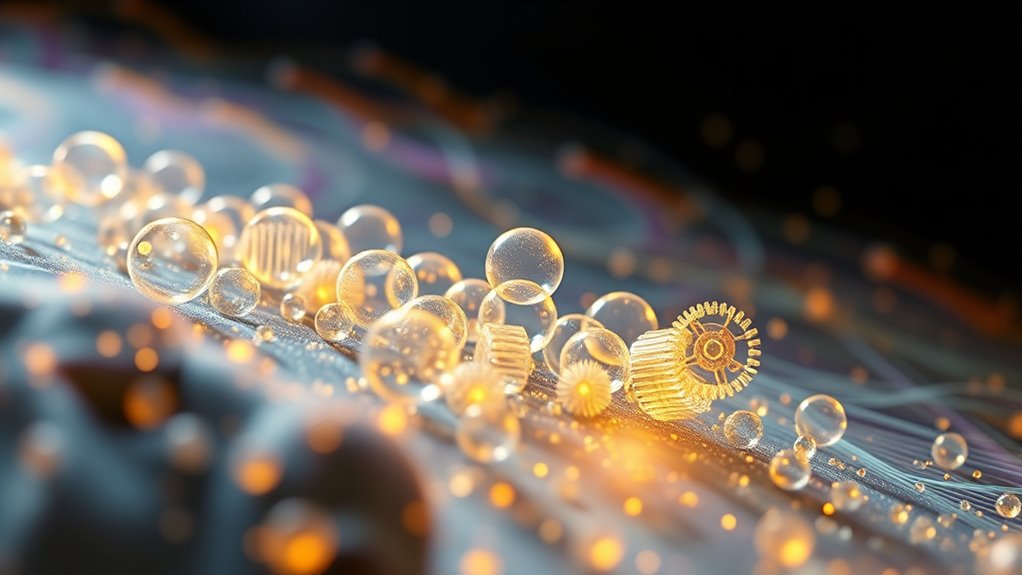
Ultrasound serves as a precise external trigger that can activate nanomachines, allowing controlled release of drugs or initiation of therapeutic actions. When exposed to ultrasound, nanomachines respond by changing their structure or behavior, releasing their payload exactly where needed. This targeted activation minimizes side effects and enhances treatment efficacy. The interaction depends on factors like ultrasound frequency and intensity. High refresh rates enhance the responsiveness of nanomachines, enabling quicker therapeutic reactions. The control ensures you can tailor therapies to specific tissues or conditions, optimizing outcomes with minimal invasiveness.
Applications in Diagnostics and Imaging Enhancements
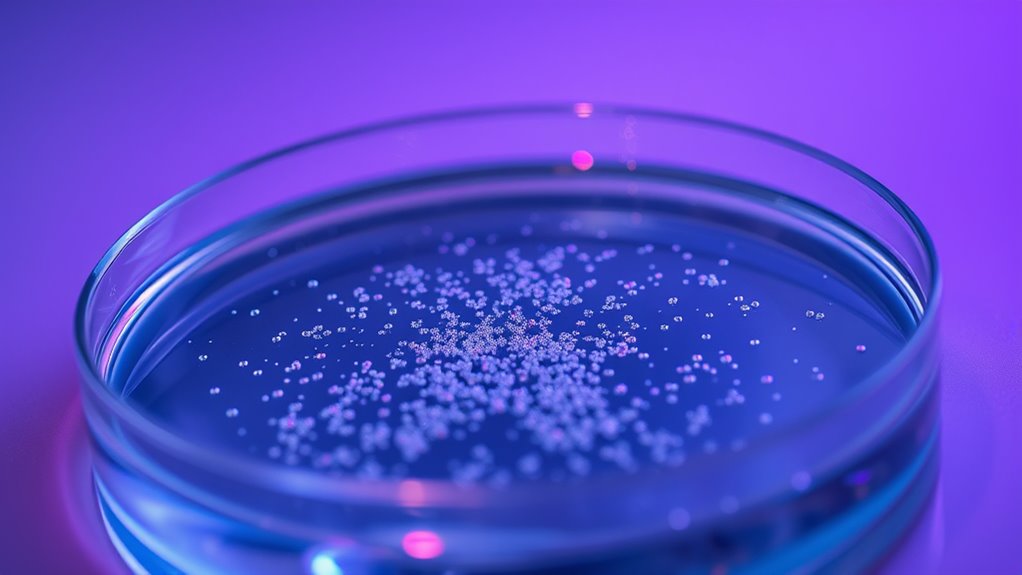
Nanobubbles and ultrasound-driven nanomachines can remarkably improve diagnostic imaging by serving as advanced contrast agents. They enable more targeted disease detection and provide clearer, more detailed images. As a result, imaging resolution gets a boost, making diagnoses more accurate and efficient. Moreover, these technologies can be tailored to specific medical conditions, enhancing the precision of treatments and interventions.
Improved Contrast Agents
Recent advancements in nanobubbles and ultrasound-driven nanomachines have opened new possibilities for enhancing diagnostic imaging. You can now use these nanobubbles as superior contrast agents that improve image clarity and resolution. Unlike traditional agents, nanobubbles are small enough to penetrate tissues and circulate longer, providing more detailed information. When exposed to ultrasound, they generate strong echoes, highlighting specific areas with greater precision. This targeted behavior is partly due to their scientific properties, which allow for controlled responsiveness to external stimuli. This allows you to detect subtle differences in tissue structures and identify abnormalities early. Additionally, their stability and responsiveness mean you get clearer images with less contrast agent needed. These improvements make diagnostic procedures faster, safer, and more accurate, ultimately helping you achieve better patient outcomes through enhanced visualization.
Targeted Disease Detection
Targeted disease detection has been revolutionized by the integration of nanobubbles and ultrasound-driven nanomachines, allowing you to identify specific biomarkers with unprecedented accuracy. These nanodevices can be engineered to bind selectively to disease markers, enabling precise localization within the body. When exposed to ultrasound, nanobubbles generate signals that highlight the targeted areas, improving detection sensitivity. This approach minimizes false positives and enhances early diagnosis, especially in complex tissues. You can now distinguish malignant from benign tissues more effectively, aiding in timely treatment decisions. The combination of nanobubbles’ targeting capabilities and ultrasound’s deep tissue penetration transforms diagnostics, making it possible to detect diseases at their earliest stages. This advancement paves the way for personalized medicine and more effective intervention strategies.
Enhanced Imaging Resolution
Building on advances in targeted disease detection, the integration of nanobubbles and ultrasound-driven nanomachines markedly enhances imaging resolution. These technologies produce clearer, more detailed images, allowing you to identify abnormalities with greater accuracy. Nanobubbles improve contrast, making small lesions stand out, while nanomachines precisely target specific tissues. Together, they enable real-time visualization of biological processes, improving diagnostic confidence. Here’s a visual overview:
| Feature | Benefit | Application |
|---|---|---|
| Nanobubbles | Enhanced contrast and stability | Ultrasound imaging |
| Ultrasound-driven nanomachines | Precise targeting and activation | Tumor detection |
| Improved spatial resolution | Clearer images for small structures | Diagnostics |
| Real-time imaging | Immediate feedback during procedures | Interventional radiology |
| Non-invasive | Reduced patient discomfort | Routine screenings |
This synergy pushes the boundaries of diagnostic imaging, making detection faster and more reliable.
Targeted Drug Delivery: Improving Precision and Reducing Side Effects

Nanobubbles and ultrasound-driven nanomachines offer a promising approach to targeted drug delivery by enhancing precision and minimizing side effects. You can direct therapeutic agents straight to diseased cells, sparing healthy tissue and reducing adverse reactions. When ultrasound activates nanomachines, they release drugs exactly where needed, improving treatment efficiency. This method allows you to control drug release timing and dosage, decreasing the risk of overdose or toxicity. Furthermore, nanobubbles can carry drugs through biological barriers, like the blood-brain barrier, increasing access to hard-to-reach areas. The fathers’ role in guiding character and focus on personalized medicine are essential elements that complement these technological advances. By focusing treatment precisely, you minimize systemic exposure and side effects. This targeted approach not only boosts therapeutic outcomes but also enhances patient comfort and safety, making nanobubbles and ultrasound-driven nanomachines a powerful tool in personalized medicine.
Challenges and Future Directions in Nanotechnology-Based Therapies

As you explore nanotechnology-based therapies, you’ll encounter key challenges like ensuring biocompatibility and safety, which are essential for patient trust. Achieving targeting precision remains difficult, risking off-target effects and reduced efficacy. Additionally, scaling up manufacturing processes poses hurdles that must be addressed to make these advanced treatments widely accessible. Incorporating security measures into the development process can help safeguard these innovative therapies from potential cyber threats and manipulation.
A) Biocompatibility and Safety
Ensuring biocompatibility and safety remains a critical challenge as nanotechnology-based therapies advance. You need to carefully evaluate how nanobubbles and nanomachines interact with biological systems to prevent adverse effects. Materials used must be non-toxic and biodegradable, minimizing immune responses or toxicity. You should also consider potential long-term accumulation and clearance from the body, which could pose safety risks. Rigorous preclinical testing is essential to identify any unintended interactions or side effects. Additionally, understanding filtration technologies is vital for designing nanomaterials that effectively remove or neutralize harmful agents without causing harm. Regulatory frameworks are still catching up with these innovations, so establishing standardized safety protocols is essential. Ultimately, your goal is to develop nanotechnologies that are both effective and safe for patients, ensuring that their benefits outweigh potential risks.
B) Targeting Precision Challenges
While advancements in biocompatibility and safety are vital, achieving precise targeting remains a significant hurdle in nanotechnology-based therapies. You often face challenges in ensuring nanobubbles or nanomachines reach the exact location without affecting surrounding tissues. Biological barriers like the immune system, blood flow dynamics, and tissue heterogeneity can divert or trap these nanocarriers, reducing their effectiveness. Additionally, the variability in disease markers complicates targeting strategies, making it hard to design universally effective systems. You need to develop smarter targeting mechanisms, such as ligand-based or stimulus-responsive approaches, to improve specificity. Overcoming these challenges is essential for maximizing therapeutic benefits while minimizing side effects. Future research must focus on refining targeting accuracy to fully realize the potential of nanomedicine.
C) Scalability and Manufacturing
Scaling up nanotechnology-based therapies presents significant manufacturing challenges that must be addressed to shift from laboratory research to clinical applications. You need reliable, large-scale production methods that guarantee consistent quality, stability, and safety of nanobubbles and nanomachines. Current fabrication techniques often lack scalability and can be costly or complex to reproduce. Achieving uniformity in size, surface properties, and payload loading becomes increasingly difficult at larger volumes. Additionally, regulatory compliance and sterilization procedures add layers of complexity. To overcome these hurdles, you must develop scalable manufacturing processes, such as continuous flow synthesis and automation, that maintain precision and quality. Advancing these techniques will be vital for translating nanotherapy innovations from bench to bedside, ensuring they are feasible for widespread clinical use. Typical store hours can vary, highlighting the importance of planning for manufacturing schedules and quality control during large-scale production.
Emerging Trends and Potential Impact on Personalized Medicine

Emerging trends in nanobubbles and ultrasound-driven nanomachines are poised to revolutionize personalized medicine by enabling highly targeted and minimally invasive treatments. These innovations allow for precise delivery of drugs, reducing side effects and improving efficacy. Advances in real-time imaging and controlled activation mean therapies can adapt dynamically to individual patient needs. Additionally, integrating nanotechnology with diagnostics enhances early detection and personalized treatment plans. As research progresses, you’ll see more customizable nanobubbles tailored to specific diseases. The potential for combining multiple functionalities—such as imaging, drug delivery, and tissue repair—opens new horizons in patient care. These trends promise a future where treatments are not only personalized but also smarter, safer, and more effective.
- Integration with AI for predictive treatment customization
- Development of multi-functional nanobubbles for combined therapy
- Enhanced control over nanomachine activation and targeting
- Use of patient-specific nanomaterials for personalized therapy
- Real-time monitoring of treatment response
Frequently Asked Questions
How Long Do Therapeutic Nanobubbles Typically Remain Active in the Body?
Therapeutic nanobubbles usually stay active in your body for about 10 to 30 minutes. This duration depends on factors like the size of the bubbles, the site of injection, and how quickly your body breaks them down. During this time, they can deliver drugs or trigger other therapeutic effects. Afterward, your body naturally clears them out through the lymphatic system or other metabolic processes.
Are There Any Known Side Effects or Toxicity Concerns With Nanomachines?
You should be aware that nanomachines can cause side effects like tissue damage, immune reactions, or toxicity if not carefully designed. While research is ongoing, some concerns include unintended interactions with healthy cells or accumulation in organs, which might lead to long-term issues. It is crucial to follow safety guidelines and conduct thorough testing to minimize risks and ensure these technologies are safe for clinical use.
What Are the Cost Implications of Implementing Nanotechnology-Based Therapies?
Like steering uncharted waters, implementing nanotechnology-based therapies can be costly initially. You’ll face expenses for research, specialized equipment, and training, much like building a ship before sailing. However, over time, these investments may pay off through more effective, targeted treatments, reducing long-term healthcare costs. While the upfront costs are high, embracing nanotech could revolutionize medicine, making future health solutions more efficient and personalized, like a well-charted voyage.
How Do Nanobubbles Target Specific Tissues or Cells Selectively?
You target specific tissues or cells with nanobubbles by attaching specialized ligands or antibodies that recognize unique markers on the target. When administered, these nanobubbles circulate and bind selectively to the desired cells, guided by their surface modifications. Ultrasound then triggers the nanobubbles to release their payload precisely at the target site, ensuring focused therapy while minimizing effects on surrounding healthy tissues.
Can These Nanotechnologies Be Integrated With Existing Medical Devices?
Yes, you can integrate these nanotechnologies with existing medical devices. Researchers develop compatible interfaces that allow nanobubbles and nanomachines to work seamlessly with ultrasound machines, catheters, or imaging systems. You might see them combined in targeted drug delivery or diagnostics, enhancing precision and effectiveness. This integration improves treatment outcomes by combining nanotech’s specificity with the proven capabilities of current medical devices, making therapies safer and more efficient.
Conclusion
You’re now aware that therapeutic nanobubbles and ultrasound-driven nanomachines are revolutionizing medicine, offering targeted treatments with fewer side effects. Did you know that ultrasound-activated nanobubbles can increase drug delivery efficiency by up to 300%? As research advances, you can expect even more precise, personalized therapies that transform patient outcomes. Embracing these innovations means you’re on the cusp of a new era in medical treatment, where technology truly puts healing in your hands.

